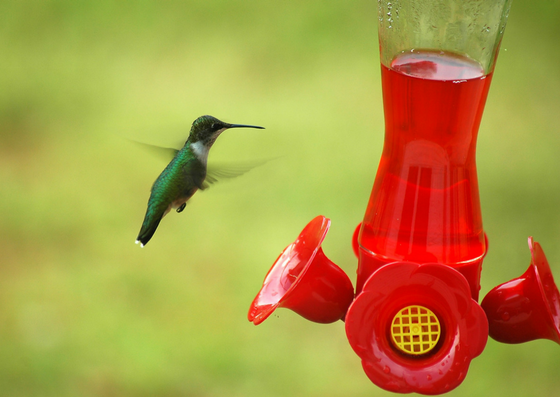
Grandpa has a hummingbird feeder. He has had one for decades, wherever he has lived. If a hummingbird visits his feeder, we stop all conversation to lovingly stare at the sleek little body warily humming near us. If you are playing Grandpa in Apples to Apples, save the hummingbird card for him because he will always pick it. Hummingbirds are that sacred.
So when we eventually started being real adults, with our own yard, we decided to put out a hummingbird feeder of our own. We thought it would make Grandpa happy when he came to visit. But it turns out, it is rewarding for all. The kids especially love it. And, of course, all conversation in our own house now stops when a hummingbird swings by. These amazing creatures are a sure sign that God is pretty awesome and that nature is far more intricate and precious than we can comprehend.
It is hard to see these creatures in the wild (they move too fast and are too small). But if you have a feeder, they show up!
You can have a hummingbird feeder, too. It is easy to do.

Please note there are affiliate links below.
Here is how to have a hummingbird feeder:
- It is more than likely that you have hummingbirds in your yard. They are found in most of North America, Mexico, and Canada. But for confirmation, visit this chart from Hummingbird Guide.
- Hummingbird feeders can be placed as early as mid-March, but April and May are high traffic times due to migration patterns. In our area, hummingbirds continue to visit until early October.
- Purchase a durable feeder, and try to get a glass top with a plastic reservoir (mold and bacteria grows slower in the glass feeders). Feeders are also available at garden and home improvement stores around the nation. The red base seems to attract the birds, and it is more effective to have several small feeders around the yard than one large one. So don’t feel as though you need to spring for the supersized feeder.
- Find a place to put your feeder. We use a railing hook and clamp it to our porch railings. The hummingbirds end up coming quite close to the house (and no, they have never flown into a window – that is not a general concern with hummingbirds). You can also use a shepherd hook to place the feeder further in the yard. But do try to place it in the shade (it attracts more birds) if you can.
- Make a water/sugar mixture. Do NOT buy special nectars. All you need is sugar and water. Use a ratio of 4:1 (e.g., four cups water to one cup of sugar). It is necessary to dissolve the sugar, which is usually quickly done by boiling the mixture. Boiling will also kill mold and bacteria.
- Allow the mixture to cool then place it in your feeder. Red food coloring is NOT necessary!
- The sugar mixture can sit out for about two weeks before it needs to be changed – although usually, hummingbirds will drink the mixture well before then. If you have any doubts about consumption rate, do not fill the feeder completely until you know how quickly your birds are drinking. Sugar water left out too long can grow mold and attract ants.
- To clean your feeder (which we do about once a month if they are drinking quickly, more frequently if they are drinking slowly), you can gently rinse it with white vinegar and water. Do NOT use bleach or other highly astringent cleaners.
- If you are wondering what kind of hummingbirds you see, see Hummingbird Central for photos and descriptions. Once you put out a feeder, hummingbirds will likely return to your yard the next year during their migration.
This truly is a fun and easy way to encourage a relationship with nature for the kids. And, of course, Grandpa loves it, too.
Last Updated on May 4, 2018 by Mrs. Family Trip
